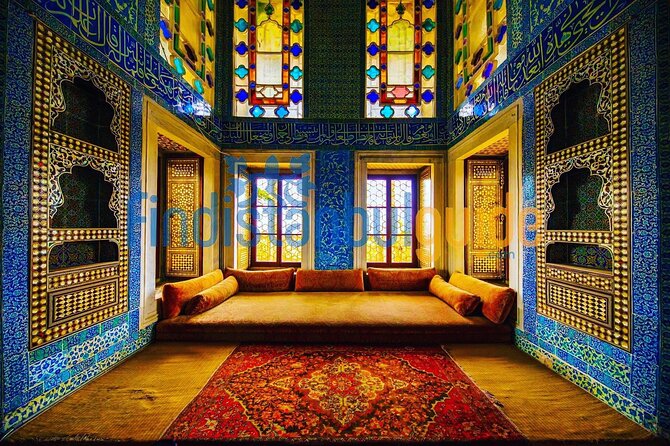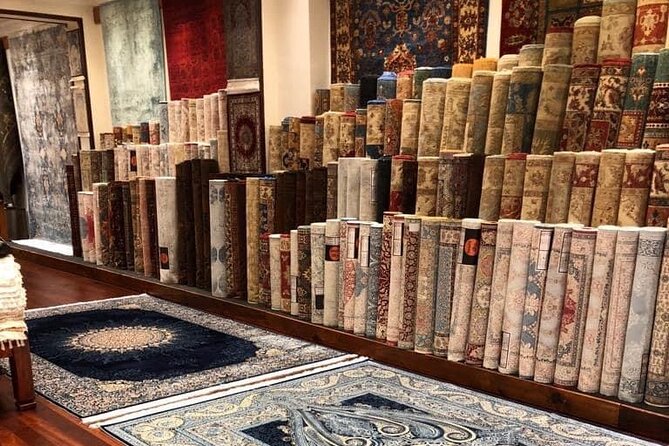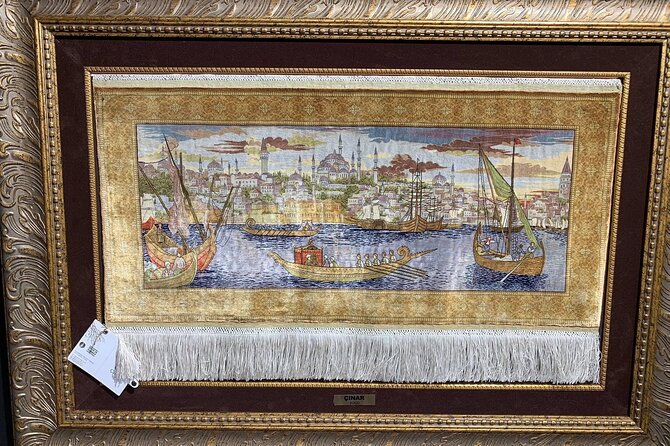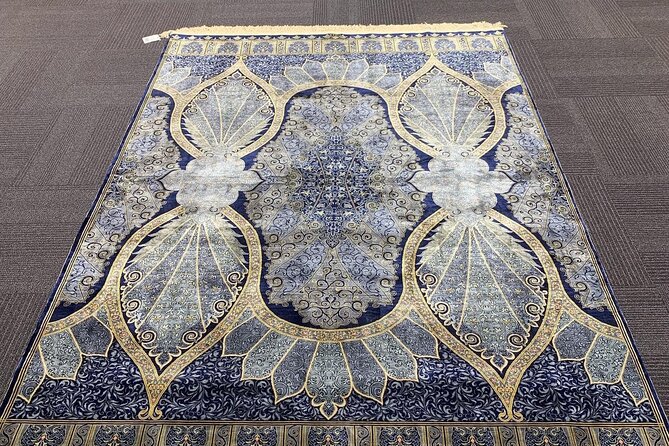Turkish Carpet
Step into the intricate tapestry of Turkish carpets, where each thread tells a story steeped in tradition and artistry.
The allure of these carpets goes beyond mere decoration, offering a glimpse into a rich cultural tapestry that has woven its way through history.
From the Anatolian plains to the bustling bazaars of Istanbul, Turkish carpets have stood the test of time as symbols of craftsmanship and heritage.
But what secrets lie beneath their intricate patterns and vibrant hues, waiting to be unraveled?
Key Points

- Turkish carpets showcase intricate craftsmanship and cultural significance.
- They come in various types like Double Knot and Flatweave Carpets.
- Designs reflect daily life, nature, and past civilizations.
- Care involves regular vacuuming, blotting spills, and professional maintenance for longevity.
History and Origin

The history and origin of Turkish carpets date back centuries, showcasing intricate craftsmanship and cultural significance. These carpets hold immense historical significance, reflecting the artistic traditions and weaving techniques passed down through generations.
Turkish carpets are known for their vibrant colors, intricate designs, and durability, making them prized possessions and sought-after decorative pieces worldwide. The weaving techniques used to create Turkish carpets vary from region to region, with each area having its unique style and patterns.
Some common weaving methods include the symmetrical knot and the asymmetrical knot, which contribute to the distinct look and feel of Turkish carpets. Through these weaving techniques, artisans bring to life stunning carpets that not only beautify spaces but also tell stories of Turkey’s rich cultural heritage.
Types of Turkish Carpets

With a rich history and diverse weaving techniques, Turkish carpets encompass a variety of types that showcase unique patterns and craftsmanship passed down through generations. Turkish carpets are renowned for their intricate designs and high-quality materials. Here are some common types:
-
Double Knot (Turkish Knot): Turkish carpets are known for their unique double knotting technique, which creates a more durable and dense pile compared to other weaving methods.
-
Wool and Silk Composition: Traditional Turkish carpets are often made from high-quality wool and silk, which give them a luxurious feel and vibrant colors that last for generations.
-
Flatweave Carpets (Kilims): Kilims are a type of Turkish carpet that’s flat-woven without a pile, showcasing intricate geometric patterns and bold colors.
Symbolism and Design
Symbolism and design in Turkish carpets intertwine cultural heritage with intricate patterns and meanings that captivate admirers worldwide. The symbolism interpretation in Turkish carpets often reflects aspects of daily life, nature, and spiritual beliefs of the weavers.
These carpets showcase a rich history where each design holds a specific significance, whether it be protection from evil, fertility, or good luck. Over the centuries, the design evolution of Turkish carpets has seen influences from various civilizations, resulting in a diverse range of patterns and color schemes.
From geometric motifs to floral designs, each element in a Turkish carpet tells a story that connects the past with the present, making them not just decorative pieces but cultural artifacts worth cherishing.
Production Process Overview
Intertwining centuries-old techniques with modern innovations, the production process of Turkish carpets exemplifies a harmonious blend of tradition and craftsmanship.
-
Dyeing Techniques: Turkish carpets are renowned for their vibrant colors achieved through intricate dyeing processes using natural ingredients like plants, insects, and minerals.
-
Weaving Methods: Skilled artisans employ traditional hand-knotting techniques to create intricate patterns and designs, ensuring each carpet is a unique masterpiece.
-
Regional Variations: Different regions in Turkey have distinct weaving styles and patterns, influenced by local traditions and cultural heritage, showcasing the diverse artistic expressions of Turkish carpet making.
Best Practices for Care
Employing proper care techniques is essential to preserve the beauty and longevity of your Turkish carpet. To maintain its exquisite appearance, regular vacuuming with a brushless suction head is recommended to prevent fraying or damage.
In case of spills, blot the area gently with a clean cloth to avoid spreading and seek professional cleaning if necessary. For long-term preservation, rotate the carpet periodically to ensure even wear.
If your Turkish carpet experiences any tears or loose threads, consider professional repair methods to prevent further deterioration. Restoration services can also be utilized to revive older or worn-out carpets, enhancing their aesthetic appeal and value.
Buying Guide and Tips

When looking to purchase a Turkish carpet, consider these essential buying guide and tips to make an informed decision and find the perfect piece for your space.
-
Buying Tips: Ensure the authenticity of the carpet by looking for a label or certificate of origin. Authentic Turkish carpets are typically handwoven and made from high-quality materials like wool or silk.
-
Market Trends: Stay informed about current market trends to understand the pricing and quality of Turkish carpets. Research bargaining strategies to negotiate a fair price with sellers.
-
Bargaining Strategies: Don’t hesitate to bargain when purchasing a Turkish carpet. It’s common practice in Turkey, and sellers may be willing to offer discounts, especially in local markets.
Popular Patterns and Colors
Popular patterns and colors in Turkish carpets reflect a rich tapestry of cultural heritage and artistic expression, captivating buyers with their intricate designs and vibrant hues. Turkish carpets are known for their bold colors like red, blue, and green, symbolizing various aspects of life such as joy, prosperity, and nature. These colors are carefully chosen based on color psychology to evoke specific emotions and energies in different spaces.
Plus, market trends influence the popularity of certain patterns, with traditional motifs like the ‘medallion’ and ‘prayer rug’ designs being timeless favorites. As buyers seek both aesthetic appeal and meaning in their carpets, the interplay between color choices and traditional patterns continues to drive the market for Turkish carpets.
Cultural Significance
Reflecting a centuries-old tradition of craftsmanship and artistry, Turkish carpets hold profound cultural significance, embodying the heritage and storytelling of the Turkish people through their intricate weaves and symbolic motifs.
These carpets aren’t merely decorative pieces but serve as carriers of history and tradition, symbolizing cultural importance and the preservation of ancestral skills.
The artisan techniques and craftsmanship involved in creating Turkish carpets are passed down through generations, ensuring the continuation of these intricate weaving methods.
Common questions
Are Turkish Carpets Only Used for Decorative Purposes, or Do They Have Practical Uses as Well?
Turkish carpets blend practical uses with cultural significance. Not just decorative items, they also serve functional roles like insulation and sound absorption. Beyond adornment, these carpets reflect tradition and craftsmanship, enriching spaces with history.
How Do Turkish Carpets Differ From Carpets of Other Cultures in Terms of Materials Used and Weaving Techniques?
Turkish carpets stand out due to the exceptional quality of materials like wool and silk. Skilled artisans employ intricate weaving techniques passed down for generations. This craftsmanship results in unique patterns and durability that set Turkish carpets apart from others.
Are There Specific Regions in Turkey Known for Producing Higher Quality Carpets, and if So, What Sets Them Apart?
In Turkey, specific regions excel in producing higher quality carpets due to their unique weaving techniques and choice of materials. These regional differences contribute to the cultural significance of Turkish carpets, setting them apart in the market.
What Are Some Lesser-Known Cultural Traditions or Beliefs Associated With Turkish Carpets That Are Not Commonly Discussed?
When exploring lesser-known cultural aspects, one might discover traditional beliefs, symbolic meanings, cultural rituals, and spiritual connections that enrich the understanding of a subject. These hidden gems offer a deeper dive into diverse customs and practices.
How Have Modern Technologies and Innovations Impacted the Traditional Art of Turkish Carpet Making?
Modern technologies have revolutionized industries worldwide. The impact of automation is profound, streamlining processes yet raising concerns about job displacement. Balancing automation with the preservation of craftsmanship remains a key challenge for traditional arts, ensuring a harmonious blend of innovation and heritage.
Last Words
To sum it up, Turkish carpets aren’t just ordinary floor coverings but cherished works of art that reflect the rich cultural heritage and exquisite craftsmanship of Turkey.
With intricate designs, vibrant colors, and deep symbolic meanings woven into every pattern, these carpets continue to captivate art enthusiasts and historians worldwide.
From their traditional production techniques to their cultural significance, Turkish carpets stand as timeless masterpieces that enchant and inspire all who behold them.